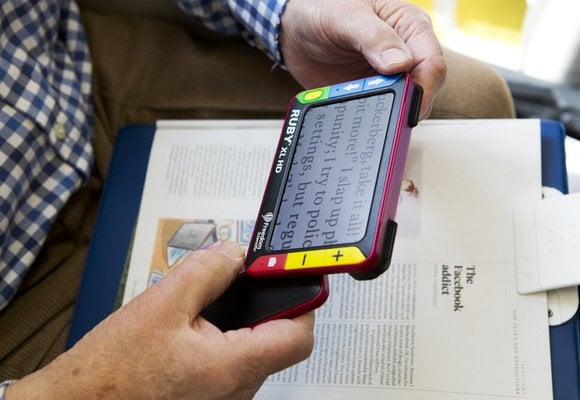Accessible smartphones are available to apply for through the RNIB Technology Grant Scheme. Other items include video magnifiers, RNIB PenFriend 3, kitchen equipment, clocks and watches, RNIB mobile phone accessibility software and DAISY players. Click here for more information about grants.
A guide to Apple devices for people with sight loss
A basic RNIB introduction to Apple products for the blind and partially sighted users, including use and set up.
Smartphones and tablets designed by Apple are called iPhones and iPads.
Unlike Android, where products are made by many different manufacturers, Apple design their own hardware and the software that runs on it, which is known as iOS. They all use touch screen technology to control the device.
All Apple devices have built in accessibility through options like speech feedback called VoiceOver, screen magnification called Zoom, inverted colours, bold text and their own built in video magnifier for reading printed materials meaning that Apple products are excellent options for blind and partially sighted people.
Products range in size from 8 inches to 12.9 inches. The iPhone and iPad can run many similar applications to add functionality.
Any Apple iPhone or iPad needs to be set up with your personal details like Apple ID, Wi-Fi network key, pass code, fingerprint or face ID and any data transferred from an older device.
In addition, Apple devices can be set up independently using accessibility options at start up. In this way you can use the built in tools like VoiceOver or Zoom to set up the device.
A touch screen can seem a little daunting at first, but with practice it is very usable if you are blind or partially sighted. By touching the screen and using finger gestures such as flicking, tapping, sliding etc. you can control your Apple device.
We've put together a collection of more helpful videos that demonstrate some of the accessibility functions on Apple iPhones and iPads.
The magnification and speech options on an Apple device give the user access to a huge range of functions on the phone. For example, you can make calls, send texts, email, access web sites and lots more.
In addition, you can download a range of thousands of apps to enhance your Apple device's capabilities. Different apps make it easy to play radio and TV, access music, find out about transport, read documents using the built in camera, identify products and locations, identify bank notes and colours, keep in touch with friends and family, read books, manage your bank accounts and so much more.
VoiceOver is a gesture-based screen reader so the way you navigate and interact with your phone changes when VoiceOver is on. To explore the screen, drag your finger over it. VoiceOver speaks the name of each item you touch. To activate an item you double-tap.
If you want to try VoiceOver and discover what it's like using a screen reader there is a special practice area for you to have a go without affecting your iPhone or its settings.
- Go to Settings > Accessibility > VoiceOver.
- Turn on VoiceOver, tap VoiceOver Practice, then double-tap to start.
- When you finish practicing, tap Done, then double-tap to exit.
There's more information about trying out VoiceOver in the Apple iPhone User Guide.
All Apple products are accessible out of the box and don't require the purchase or installation of extra software. You can buy the latest device and have it set up within minutes all without any assistance.
Once you master the concept of the touch screen such a device will fit seamlessly into your lifestyle.
Pricing of iPhones and iPads can range from £389 to £1049 depending on screen size, storage, functionality and hardware specifications.
Although there is no RNIB iPad, they make great options for blind and partially sighted users, alternatively additional accessibility software is available from the RNIB shop which can be installed on Android devices.
Hadley are an American educational charity, whose mission is to create personalised learning opportunities that empower adults with vision loss or blindness to thrive – at home, at work and in their communities. On their website Hadley have a range of technology workshop videos that demonstrate how to use the accessibility features found on Android, Apple, Windows and smart devices. Sign up for a free account with Hadley to watch the next video in the iPhone/iPad: Low Vision Features series, or watch any of the other Hadley workshop videos.







